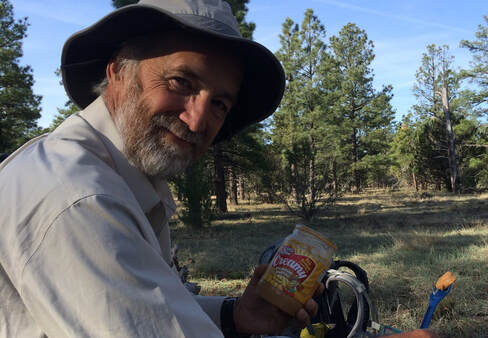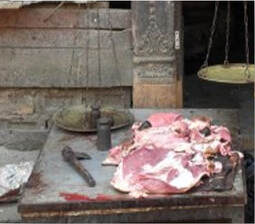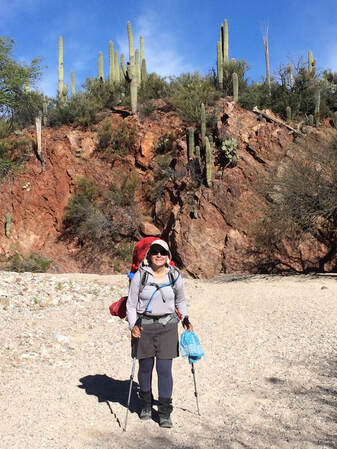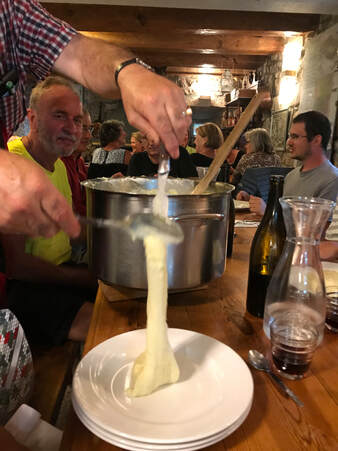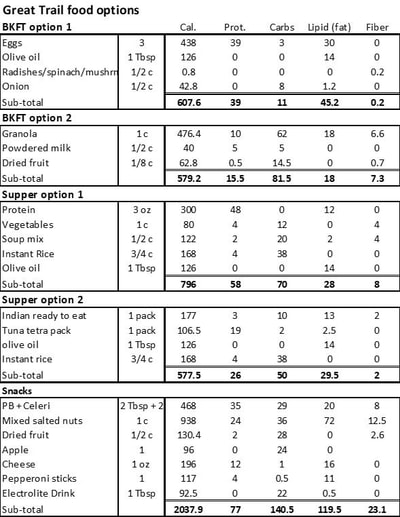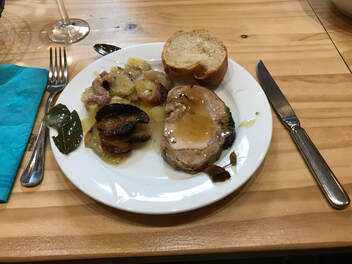Overview
Distance walking is an endurance sport that lasts at minimum a few weeks and normally several months. The athlete’s body needs certain nutrients to function well. Without proper fuel a long distance trek will be put at risk, the trekker's body will eventually weaken and breakdown. The unsuspecting distance hiker, who does not ingest proper nutrition, may speed the aging process and tissue atrophy.
|
When Simon and I walked the AZT, I had planned a menu containing about 3,500 Calories per day. I was managing well on that number of Calories, but Simon was not. We did not notice, but in the first 30 days he lost 45 lbs. He was sluggish, moody, and became hypothermic on a cold rainy day, which was unusual for him. Once we rectified this grave error, he regained some weight and his good humour.
A process worth paying attention to is autophagy. Autophagy means ‘eating of self’. It is a method of cellular ‘cleaning and recycling’ which can be used healthily with intermittent fasting. This occurs when an individual chooses to eat during a fixed, narrow, window of time during the day and fasts for the rest of the 24-hour period.
|
We strongly discourage practicing this during thru hiking. The thru hiker’s body needs about twice the usual amounts of nutrients/Calories during this arduous activity. This is not the time to fast! If autophagy does occur, the body will eat its own tissues to recycle proteins and other building blocks for metabolic functioning. This can have disastrous consequences, as muscle tissue is reabsorbed, leaving the individual weak and vulnerable to injury or illness.
An athlete would be wise to understand how many Calories he/she needs during their sport. A good starting point is knowing your BMR (basal metabolic rate). This represents the number of Calories you need for basic metabolic functions such as heart beating, breathing, and digesting. It is influenced by your gender, age, height, and weight. There are many BMR calculators online.
Now we can add to this caloric base the Calories required for activities of daily living and sport activities. Hiking burns Calories generally at a slower, steadier rate than other faster paced sports, such as running or cycling. But because thru-hiking is a long duration sport, that lasts for days, weeks, or even months, the cumulative demand on the body can be significant. The range of Calories burnt while hiking is 300 to 900 per hour, depending on your pack weight, your speed, and the terrain. It is easy to see how fast the caloric demands can increase, hiking 8 to 10 hours a day for a month!
Questions regarding the trek are important to consider when calculating caloric expenditures and menu planning.
With this knowledge base we can build a relatively accurate menu with enough Calories and nutrients to minimise detrimental effects of long-distance walking. We typically calculate twice the ‘at home’ Calories for our treks.. Julie (1.6m/68kg/59 yrs.) does well at home with 1,800 Ca and with 3,500 Ca while Simon (1.8m/80kg/62 yrs.) fares better with 2,500 Ca at home and 5,000 Ca/day. For more detail on the fundamentals of nutrition (macronutrients, etc.) click here.
An athlete would be wise to understand how many Calories he/she needs during their sport. A good starting point is knowing your BMR (basal metabolic rate). This represents the number of Calories you need for basic metabolic functions such as heart beating, breathing, and digesting. It is influenced by your gender, age, height, and weight. There are many BMR calculators online.
Now we can add to this caloric base the Calories required for activities of daily living and sport activities. Hiking burns Calories generally at a slower, steadier rate than other faster paced sports, such as running or cycling. But because thru-hiking is a long duration sport, that lasts for days, weeks, or even months, the cumulative demand on the body can be significant. The range of Calories burnt while hiking is 300 to 900 per hour, depending on your pack weight, your speed, and the terrain. It is easy to see how fast the caloric demands can increase, hiking 8 to 10 hours a day for a month!
Questions regarding the trek are important to consider when calculating caloric expenditures and menu planning.
- How heavy is the carry weight? A light day pack will require less effort than a heavy multi-day pack.
- How much elevation gain/loss is expected on this trek? How challenging is the trail?
- How fast a pace will you maintain? How long is the trek expected to last?
With this knowledge base we can build a relatively accurate menu with enough Calories and nutrients to minimise detrimental effects of long-distance walking. We typically calculate twice the ‘at home’ Calories for our treks.. Julie (1.6m/68kg/59 yrs.) does well at home with 1,800 Ca and with 3,500 Ca while Simon (1.8m/80kg/62 yrs.) fares better with 2,500 Ca at home and 5,000 Ca/day. For more detail on the fundamentals of nutrition (macronutrients, etc.) click here.
Factors worth considering
|
As we highlighted in the equipment section, we use exploration factors to guide us as we investigate all aspects of a trail. This information is necessary to be well prepared.
Landscape Food choice will vary greatly with different geographical locations. On mountainous treks, menus will most likely be based on dried foods. Treks in foreign countries add a gastronomic adventure to a trek. As well, food preparation, refrigeration, and sanitation can be quite different in other countries. Doing research prior to leaving for regional food options, and how to minimise gastric disorders will reduce unfortunate events. |
|
Prior to leaving for our Nepal trek, we had an appointment with an immunization specialist. We were recommended some inoculations and a dose of Dukoral which would help reduce gastric distress while travelling. Once in Nepal, after passing a butcher shop in Katmandu, we opted to only eat vegetarian foods on our trip. The scene in the butcher shop was as follows: a man sitting on the dirt floor was chopping meat and poultry on a wood block and placing the chopped meat onto a marble slab. The meat was sold from the slab where flies had been feasting. Yuck!
|
|
Warm and hot environments may require different considerations for menu planning. Fresh food items will not keep without refrigeration for more than a day or two. Cheese and sausage become a greasy mess in your bag. Limit these items during long treks in warm environments.
Trail bars, nut butters, and cheese may be so hard in very cold climates to become inedible. Placing some foods in the sleeping bag may reduce the chance that they freeze hard and become unusable, but it will make for an uncomfortable night. Skills Having basic practical skills in planning an expedition menu, preparing, packaging the meals, and knowing how to cook or rehydrate them in the wilderness are essential skills for a wilderness thru-hike. Being proficient with handling the camp stove is equally important. Practice at home in different weather. Try cold-soak, warm soak techniques (described below in this section) to get acquainted with the outcomes of each. Being proficient with these techniques will provide confidence and reduce potential frustration on the trail. |
Finances
Menu planning for long treks can be costly. We look for less expensive ways to eat well on the trail. We plan a budget for the food menu. Given a good amount of time prior to leaving on the trek, we purchase and prepare food gradually, or save to have enough cash on hand for the trip.
On hostel style treks, we purchase foods in grocery stores along the way and make our own meals as much as possible. Local farmer’s markets are great; there, we find local specialties, baked goods, fresh produce, sausages, and cheeses. Keep in mind that on some remote treks, hostels will be the only source of food and therefore will be more expensive.
For wilderness treks, the manufactured freeze-dried meals can be expensive when planning a menu for a month or more. Sometimes buying in bulk can reduce the costs. Companies, such as Mountain House, are worth looking into for bulk dehydrated foods. They offer large volume containers of dry ingredients such as meat, eggs, vegetables, or prepared meals. The singular food items can be blended with a starch component (rice or pasta), or a soup mix to form a complete meal.
Bulk food stores can offer some options such as dried vegetables, dehydrated bone broth, instant soup mixes, powdered peanut butter, powdered drinks, nuts, and dried fruit. You can also find specialty items such as protein powders, chia, flax seeds, and MCT powder at these stores. Mix and match ingredients to create meals.
Menu planning for long treks can be costly. We look for less expensive ways to eat well on the trail. We plan a budget for the food menu. Given a good amount of time prior to leaving on the trek, we purchase and prepare food gradually, or save to have enough cash on hand for the trip.
On hostel style treks, we purchase foods in grocery stores along the way and make our own meals as much as possible. Local farmer’s markets are great; there, we find local specialties, baked goods, fresh produce, sausages, and cheeses. Keep in mind that on some remote treks, hostels will be the only source of food and therefore will be more expensive.
For wilderness treks, the manufactured freeze-dried meals can be expensive when planning a menu for a month or more. Sometimes buying in bulk can reduce the costs. Companies, such as Mountain House, are worth looking into for bulk dehydrated foods. They offer large volume containers of dry ingredients such as meat, eggs, vegetables, or prepared meals. The singular food items can be blended with a starch component (rice or pasta), or a soup mix to form a complete meal.
Bulk food stores can offer some options such as dried vegetables, dehydrated bone broth, instant soup mixes, powdered peanut butter, powdered drinks, nuts, and dried fruit. You can also find specialty items such as protein powders, chia, flax seeds, and MCT powder at these stores. Mix and match ingredients to create meals.
On the Trans Canada Trail, we carried four soup bases, converted rice and couscous. At mealtime we would blend a soup base with dried or fresh vegetables, some protein, and a starch. This way, we enjoyed a different combination every day.
Costco offers good pricing on larger cartons of items such as cereals, snack bars, converted rice, dry mashed potato flakes, Ramen style noodles, nuts, dried fruits, sausage meats, jerky, and cheese. Do a price check of the local grocery stores of your area. When buying large quantities of food for a trek a savings of a few dollars here and there adds up.
If you can, consider making home-made dehydrated meals. We refer to 'Recipes for Adventure' by Glen McAllister. There are countless resources on the Web and in bookstores. We have some information on dehydrating meals at home, click here.
If you can, consider making home-made dehydrated meals. We refer to 'Recipes for Adventure' by Glen McAllister. There are countless resources on the Web and in bookstores. We have some information on dehydrating meals at home, click here.
|
Trail Styles
A hostel trek, or guided tour may offer more fresh food options. Meals may be prepared for the trekker by the hosts or guides. It may be possible to purchase foods from markets and grocery stores or stop at a restaurant for a meal along the way. This is a perfect opportunity to sample local specialties and to meet people from the region. For these adventures most of the nutritional planning will focus on researching the location of shops, hours of operation, meal schedules, and local specialties. On the Camino Frances and on the GR65, we crossed groceries daily. Our meal plan incorporated stops at the local cafes for a croissant or tortilla (quiche type dish), or fresh baguette and cheese for breakfast. Lunches, and dinners would consist of hearty salads with fresh vegetables, canned beans, olives, meats, and cheese. If communal meals were available, we would partake. They were typically copious and offered a chance to get to know fellow travelers. |
|
Vegetarians and vegans may find it challenging to follow their preferred diet in some countries where meat is an important component of every meal. There may be times, where an omnivore may choose a vegetarian option to avoid eating meats of questionable freshness. Planning prior to leaving for the trek may help reduce some problematic situations. Consider carrying some foods and snacks with you if no suitable meals are available for you.
We met Jackie on the GR20 in Corsica. She was a vegetarian. The communal evening meals were prepared by our gîtes hosts. They were hearty meals that contained meat. She asked for the vegetarian option to which the host simply scooped out the meat from her portion. It was then that she realised, there was no vegetarian option.
This table describes the details for meal options on the Trans Canada Trail. On this 13,500km trek, we crossed grocery stores every three to five days. We purchased a base of dry goods, and then supplemented it with fresh vegetables (carrots, broccoli, etc.), fruits (apples, oranges), and cooked meats (deli chicken, or roast beef). On the shopping days, we enjoyed salads, and/or yogurt with fruit in town, and carried 6 eggs, and/or fresh produce for the next day.
|
For wilderness treks, the nutritional planning becomes more complex. On these treks, freeze-dried and dehydrated foods are at the center of the menu plan. They are lighter and less bulky to carry than fresh foods.
There are good, freeze-dried meals sold in outdoor stores and on-line. Make sure to read the labels for the ingredients and nutrient information. Remember to look at the Calories per serving! Whenever possible chose meals with a higher Caloric count. An example of this is trail bars. Those that contain nuts and/or coconut are higher in Calories per weight than the granola or fruit bars.
There are always new products coming on the market. New trail bars and ready to eat meals can offer variety to your menu planning. Check out what other hikers are posting on their websites and videos. We suggest trying out a few of these meals at home. Cook them on your camp stove. Being familiar with the products and how to prepare them will give you confidence and prevent you from having meals you do not like on the trip.
Time Commitment
How much time do you have for the preparation of your adventure? As described above, choosing to cook and dehydrate your own meals takes a lot of time. While planning the AZT (a 60-day wilderness trek), it took about three months of cooking and drying to prep all our meals. We had the luxury of time, and this method offered variety, nutrition, and less expensive meals.
Health and Safety
Maximising nutrition and eating the correct number of Calories will reduce the chance of becoming malnourished and ill. Constant attention needs to be placed on the food choices we make.
There are good, freeze-dried meals sold in outdoor stores and on-line. Make sure to read the labels for the ingredients and nutrient information. Remember to look at the Calories per serving! Whenever possible chose meals with a higher Caloric count. An example of this is trail bars. Those that contain nuts and/or coconut are higher in Calories per weight than the granola or fruit bars.
There are always new products coming on the market. New trail bars and ready to eat meals can offer variety to your menu planning. Check out what other hikers are posting on their websites and videos. We suggest trying out a few of these meals at home. Cook them on your camp stove. Being familiar with the products and how to prepare them will give you confidence and prevent you from having meals you do not like on the trip.
Time Commitment
How much time do you have for the preparation of your adventure? As described above, choosing to cook and dehydrate your own meals takes a lot of time. While planning the AZT (a 60-day wilderness trek), it took about three months of cooking and drying to prep all our meals. We had the luxury of time, and this method offered variety, nutrition, and less expensive meals.
Health and Safety
Maximising nutrition and eating the correct number of Calories will reduce the chance of becoming malnourished and ill. Constant attention needs to be placed on the food choices we make.
We saw many young people on the Camino Frances eating small salads for their main meals. At home, this was probably their habit. After two weeks of distance walking though they were struggling. They were not consuming enough calories and nutrients for the energy they were exerting.
|
As stated before, if you follow a special diet, or have food allergies or specific preferences it is recommended to research ahead of time what will be available on the trek. Grocery stores vary greatly from community to community. Items found in your town, may be hard to find in smaller municipalities. As well, travelling in other countries will introduce different foods into the mix.
Some dietary disorders may require specific research and support. A person with celiac disease needs to be incredibly careful purchasing any processed foods or eating communal meals. Gluten can be hidden in many foods and would cause great gastric distress. A diabetic’s blood sugar can shift quickly and lead to dangerous situations. Understanding how extreme exercise will affect blood sugars, and when to plan meal breaks will be crucial. |
Jen joined us on a trek in the deserts of the Southwest USA. She is diabetic. Although very fit, the added stress of the temperatures and elevation on the trek deregulated her blood sugar. She became very disoriented, dizzy, and weak. Her partner had to persuade her to ingest some sugar tablets to get her levels stabilised.
In some areas of the world food preparation and water cleanliness will be drastically different from home. Being observant of how foods are being stored, washed, and cooked may mean the difference between a wonderful travel experience or a bowel cleansing scenario!
One rule we follow whenever we are on the trail is “clean hand eating”. Hand sanitising can be a challenge in the wild. Having access to clean water and soap when you just had a privy break is rare. To minimise sharing fecal bacteria with your fellow travelers, it is best to follow a custom that many nationalities use: one hand (usually the right hand) eating for communal meals or sharing foods such as nuts. The other hand used to wipe our bottom. Pay attention and use the CLEAN hand for eating.
One rule we follow whenever we are on the trail is “clean hand eating”. Hand sanitising can be a challenge in the wild. Having access to clean water and soap when you just had a privy break is rare. To minimise sharing fecal bacteria with your fellow travelers, it is best to follow a custom that many nationalities use: one hand (usually the right hand) eating for communal meals or sharing foods such as nuts. The other hand used to wipe our bottom. Pay attention and use the CLEAN hand for eating.
We also cover additional nutritional topics such as:

